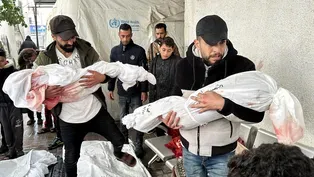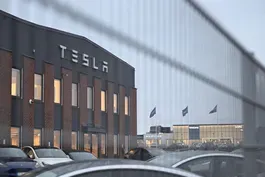
Drone warfare transforms battle between Ukraine and Russia
Clip: 12/13/2023 | 7m 51sVideo has Closed Captions
How drone warfare has transformed the battle between Ukraine and Russia
With Congress deadlocked on whether to approve tens of billions of dollars in additional aid for Ukraine, that nation's domestic arms industry is becoming increasingly important. Perhaps the most vital weapons system it's producing is an army of drones. Nick Schifrin and videographer Eric O’Connor visited the frontline in southern Ukraine to understand how drones have transformed the war.
Problems with Closed Captions? Closed Captioning Feedback
Problems with Closed Captions? Closed Captioning Feedback
Major corporate funding for the PBS News Hour is provided by BDO, BNSF, Consumer Cellular, American Cruise Lines, and Raymond James. Funding for the PBS NewsHour Weekend is provided by...

Drone warfare transforms battle between Ukraine and Russia
Clip: 12/13/2023 | 7m 51sVideo has Closed Captions
With Congress deadlocked on whether to approve tens of billions of dollars in additional aid for Ukraine, that nation's domestic arms industry is becoming increasingly important. Perhaps the most vital weapons system it's producing is an army of drones. Nick Schifrin and videographer Eric O’Connor visited the frontline in southern Ukraine to understand how drones have transformed the war.
Problems with Closed Captions? Closed Captioning Feedback
How to Watch PBS News Hour
PBS News Hour is available to stream on pbs.org and the free PBS App, available on iPhone, Apple TV, Android TV, Android smartphones, Amazon Fire TV, Amazon Fire Tablet, Roku, Samsung Smart TV, and Vizio.
Providing Support for PBS.org
Learn Moreabout PBS online sponsorshipin additional aid for Ukraine, that nation's# domestic arms industry is becoming increasingly## important.
And perhaps the most vital weapons# system it's producing is an army of drones.
Nick Schifrin and videographer# Eric O'Connor the front line in## Southern Ukraine to understand how# drones have transformed this war.
NICK SCHIFRIN: In war, there's never a# safe space.
But, in this war, when the## eyes in the sky are unblinking,# the hunters are also the hunted.
Why are we staying under the trees?
LT. ASHOT ARTIUNIAN, Ukrainian Soldier# (through translator): Because dr there are a lot of drones.
That's why# we constantly need to be under trees.
NICK SCHIFRIN: Lieutenant Ashot# Artiunian's call sign is Doc,## a reference to his Ph.D. in artificial# intelligence.
His day job is leading th volunteer drone unit on Ukraine's southern# front, their weapons, a MacBook Pro,## a tablet with real-time intelligence of Russian# positions, and a Ukrainian drone made of foam.
It's held together with duct tape, but# in a hundred billion-dollar-plus war,## it can help destroy millions of dollars of Russian# equipment.
And above the field of sunflowers## that have become symbol of Ukraine's resistance,# Ukraine's latest homemade invention takes flight.
It's flown by a three-person team# who crowdfund their equipment,## a 23-year-old from Lviv who goes by Gremlin,# call sign Hacker, who we're keeping because his family is under Russian occupation,# and an Lithuanian named Zinger.
In this drone war,## each side tries to jam the other's# drone using electronic warfare.
ZINGER, Ukrainian Soldier: We lost# the view.
They jammed the frequency,## which I cannot disclose.
There's# one frequency.
So we have opportunity to quickly switch to other# frequency, so we continue with the view.
NICK SCHIFRIN: And how often does that## happen, they t ZING NICK SCHIFRIN: Earlier in the war, outside# Bakhmut, they lost nearly a drone a day.
In total,## Ukraine's armed forces has been losing# 10,000 drones a month.
U.S. officials## admit they don't have an answer for# Russia's superior electronic warfare.
ZINGER: The Russians will drive a freaking truck# of this kind of equipment.
It's old-school, yes,## but it's going to be like many times more# powerful than this modern Western equipment.
GREMLIN, Ukrainian Soldier: Yes, actually,# Russian radio electronic warfare is really good.
NICK SCHIFRIN: For two hours, they fly# dozens of miles behind enemy lines,## hunting for Russian vehicles and the# jamming devices that are hunting them.
The live video feedback is black and# white and isn't great quality.
But## there's a second higher-quality camera on the# drone that they watch afterward back a GREMLIN: Now it's the most -- probably one# of the most important parts of our job.
NICK SCHIFRIN: In the room where they sleep# in an undisclosed location 10 miles away,## the team combs through video# their drone just filmed.
They compare today's video with satellite or drone# images from yesterday, like this Russian vehicle.
GREMLIN: Here, we noticed it's big truck, used# for bringing ammo or something like that.
So,## now we will put it into the system as a target.# I put the target, the coordinates of the targets,## put the information about it, and# then I upload this information.
It's definitely something new.# We haven't seen it yesterday.
NICK SCHIFRIN: And then they notice their# nemesis, the vehicle that jams their drone.
GREMLIN: We suspect that it can be# radio-electronic warfare system.## Looking at the shadows, you can# notice that there are seen antennas.
NICK SCHIFRIN: Oh, wow.
They sent the image a few hours later, another drone watched as a# Ukrainian shell destroyed the Russian vehicle.
Drones have changed this war and warfare,# as Ukrainians have bragged about online with## highly produced videos, from small# bombs dropped from drones to FPV,## or first-person view, drones that# can crash into military vehicles or## fly through the back of disabled vehicles.# Cheap drones destroy expensive equipment.
But it goes both ways.
Russian videos show# how Russian drones help stop Ukraine's## counteroffensive.
The U.S. assumed that# Ukraine could succeed by combining the## massing of vehicles with the movement# of troops.
Russian drones helped find## and destroy the Western supplies that were# supposed to break through Russian defenses.
And Russian drones menace Ukrainian buildings# and critical infrastructure as far west as Lviv.
In many ways, is this a war of drones?
MYKHAILO FEDOROV, Ukrainian Minister For Digital# Transformation (through translator): Today a tomorrow depends on how many drones there# will be and how they will be used.
NICK SCHIFRIN: Mykhailo Fedorov is Ukraine's# deputy prime minister and minister for## digital transformation, who's in charge of# Ukraine's effort to create an army o MYKHAILO FEDOROV (through translator):# An incredibly large industry was born## in Ukraine in one year and has# a large po NICK SCHIFRIN: Is Russia also doing the same?
MYKHAILO FEDOROV (through translator): Yes,# this war and a war of economies.
And whoever# improves the level of de their product will gain an advantage on the# battlefield, will lose less people and will## hit targets more effectively.
We have to do# everything to win the war of technologies.
NICK SCHIFRIN: Ukraine will need to# win that war with its own industry.
This is Airlogix, a drone company in an# undisclosed warehouse in Kyiv.
It's o domestic manufacturers that have increased local# production more than 100 times.
Before the war,## they designed cargo drones.
Today,# they work for Ukraine's military.
VITALLI KOLESNICHENKO, Founder and Manager,# Airlogix (through translator): Basically, we## NICK SCHIFRIN: Vitalli Kolesnichenko# is Airlogix's founder and manager.
VITALLI KOLESNICHENKO (through translator):# Wherever you look in every garage,## something is being made for the dr ones.
They are being developed everywhere# in Ukraine.
I believe that the start of Ukraine becoming the# world center of drone development.
NICK SCHIFRIN: Airlogix produces 12 to 15 drones# per month.
One of their newest is lightweight,## its parts cut with a laser out of lightweight# wood and with a 3-D printer out of rubber.
Their flagship is a reconnaissance drone# called the GOR that can fly for 25 miles## at over 10,000 feet.
It's launched by catapult and## uses artificial intelligence to# try and track possible targets.
Do you know what your long-range# drones are being used for?
VITALLI KOLESNICHENKO (through# translator): No.
It's clas (LAUGHTER) lines inside Russia.
They have# also struck the heart of Moscow.
Long term, developing long-range# drones that scale and bringing the## war to Russia's elite may be the best way# to turn the war's tide.
And Ukraine also used naval drones to attack Russian# ships.
That has helped Ukraine push the## Russian fleet far enough back to open# up Ukrainian Black Sea shipping lanes.
But Ukraine has a long way to go to build enough# drones.
And, as U.S. financing is threatened,## it will be increasingly up to Ukraine's# domestic industry to help win a drone## war where innovation and adaptation# happens every day on the front line.
For the "PBS NewsHour," I'm Nick Schifrin# in the Zaporizhzhia region, Ukraine.
COP28 nations agree to transition from fossil fuels
Video has Closed Captions
Nations at COP28 agree to transition away from fossil fuels, but loopholes remain (6m 27s)
Federal Reserve suggests it may cut interest rates in 2024
Video has Closed Captions
Interest rates remain unchanged, but Federal Reserve signals cuts coming in 2024 (5m 32s)
Impeachment expert breaks down House GOP inquiry into Biden
Video has Closed Captions
Impeachment expert Michael Gerhardt breaks down House GOP inquiry into Biden (10m 53s)
Israeli troops meet renewed resistance from Hamas in Gaza
Video has Closed Captions
Israel meets renewed resistance from Hamas amid pressure to reduce civilian casualties (9m 50s)
The self-driving safety concerns that led to Tesla recall
Video has Closed Captions
The self-driving safety concerns that led to Tesla's recall of 2 million cars (5m 21s)
Providing Support for PBS.org
Learn Moreabout PBS online sponsorshipMajor corporate funding for the PBS News Hour is provided by BDO, BNSF, Consumer Cellular, American Cruise Lines, and Raymond James. Funding for the PBS NewsHour Weekend is provided by...
















